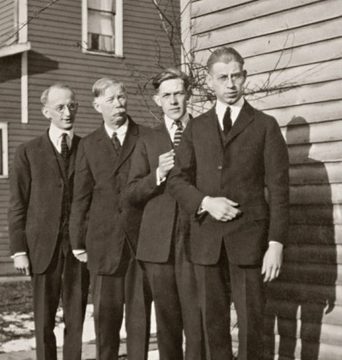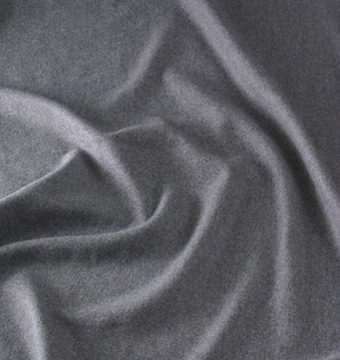
The Suit In the early 20's, the lounge suit, with its shorter jacket, began replacing the frock coat for everyday and business dress. This era also saw the birth of black tie and tuxedo for evenings, with the more formal white tie dress code fading. Gangland Chicago also had an effect with straight-leg trousers (usually 23-inch around the cuff) worn high-waisted with double-breasted waistcoats.
The Crease According to fashion history, in order to retain a pressed sharp crease in the Twenties, candle wax was applied down the inside crease of the trouser leg.

The SuitA more exaggerated silhouette prevailed at the start of the 30s, influenced by the golden age of cinema and suits worn by its leading men. Halfway through the first decade the mood changed. Loose-fitting coats were introduced and trousers were tapered towards the ankle. Even the snug waistcoat was given a more 'comfortable' fit, despite complaints it rode up when you sat down.
The CreaseIn order to improve crease retention in wool trousers in the 30’s dry soap was run down the inside trouser leg in the crease line and then ironed.

The SuitThe rationing of fabrics in the early 40's brought a new austerity to men's dress, where the focus was to minimalise and modernise the day suit. Grey flannel became fashionable, the fit of jackets was cut as straight as possible and the 'flaunting of superfluous fabric was reined in'.
The CreaseCreases were maintained by folding the trousers along the crease line and placing them under one's mattress before going to bed.

The SuitThe Brat Pack and Age of Swing saw a recovery for the suit, with the return of dressing for occasion. A wider pleated-front trouser returned, giving more mobility to dance, with teddy boys influenced by Edwardian dress favouring velvet-collared draped suits and longer jackets. The advent of leisure wear and jeans put the suit in its place, as worn mainly for the office or heading out on the town.
The CreaseWith denim being at the forefront of mainstream fashion, creases were now pressed into jeans as an emerging smart/ casual look.

The SuitThe growing inflence of teenagers and working-class heroes had a major impact. Up-and-coming stars such as Peter Sellers and The Beatles adopted the 'mod' approach with skinny-fit suits, drainpipe trousers cut short at the ankles and collarless jackets. The 60s also saw the rebirth of Savile Row, while polo-neck sweaters often replaced the shirt-and-tie combo worn with a suit.
The CreaseDuring this period, chemicals for crease retention in wool suits was introduced, the solution was applied to the fabric and then baked in order to heat set the crease.

The SuitThe birth of disco gave the suit a new role to play as a weapon of seduction. In contrast to the 60s, this decade spawned a generation of designer-clad, social climbers with a more flamboyant and liberated sense of dress. Italian fashion had international influence with exaggerated lapels, single-button fastenings and flared trousers.

The CreaseAt the Bobbin show, Atlanta, USA, our original creasing solution was launched as a dry cleanable product under the Brand name ‘Lintrak’ by the inventor, Ken Houlbrook and the International Wool Secretariat now Woolmark ™. This same year, the service was introduced to Johnsons The Cleaners in the UK. Two years later a patent was filed and the company ‘Clantex’ was formed to distribute this product worldwide.

The SuitDesigner Giorgio Armani used the Richard Gere classic “American Gigolo” to unleash a new silhouette for mainstream men's tailoring. He removed padding and jacket lining and used slouchy fabrics such as linen for pyjama-soft trousers. This played against the contrast of power-dressing Wall Street yuppies and the pastel-coloured pushed-up-sleeve blazers worn with white T-shirts by Miami drug barons.

The CreaseClantex had its first patent granted for a fully washable and dry cleanable version of the ‘Lintrak’ process. Three years later distributors were appointed for the USA and Japan with the first million dollar contract being signed. Later this same year the process was approved by Natick for use on all American Military Garments.

The SuitThe 90s' obsession with minimising technology, de-cluttering your home and a more intellectual approach to fashion gave rise to a new, any-colour-so-long-as-it's-matte-black generation. Influenced by designers Helmut Lang and Rei Kawakubo (i.e the woman behind Comme des Garcons), plus Reservoir Dogs, slim-fit suits, skinny trousers, white shirts and slim black ties were in.

The CreaseClantex expanded throughout Europe with special attention given to Police and Military contracts. In line with regulations set in 1998 the solution was tested and certified by an Independent Testing House as 'Non toxic' and ' Non Hazardous'.

The SuitIn reaction to the monochromatic anonymity of the 90s, the turn of the Millennium prised open a suppressed hedonism and unashamed flaunting of disposable income. Celebrities weren't afraid to expose their more flamboyant, feminine side. It saw luxury fabrics such as printed velvets and 'bling' embroidery play backdrop to this reincarnation of dandyism.

The CreaseClantex launched the new brand 'Supercrease®' to coincide with trading in China. At this time a newly patented precision application system was introduced to meet the demands of lighter weight fabric for Retail along with pressed creases in cotton shirts.

The CreaseThe American HQ of Supercrease® was set up in Los Angeles and later this year trading began with the largest menswear retail store in the USA where the process was offered as an add-on service in store.

The CreaseThis year heralded the process being offered within Ladieswear and Children’s School Uniforms in prestigious European stores. Three years later Clantex would formally change its name to Supercrease® in line with its corporate branding.

The SuitDesigners continue to skillfully blend retro and modern details, creating unique and relevant shapes as suit styles capture our current and direct our future era.
The Crease Supercrease® continues to expand globally offering creasing solutions to an International customer base across all sectors. New and innovative methods of applying Supercrease® continue to be discovered.